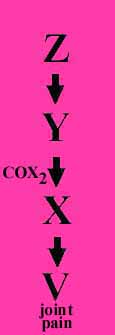Non-Steroidal Anti-Inflammatory Drugs
and Cox-2 Inhibitor
A common class of medications used in the treatment of arthritis and post-operative pain are called non-steroidal anti-inflammatory drugs, or NSAID's.
This name comes from non-steroidal (that it, they are not steroids), and anti-inflammatory (because they fight inflammation, a complex biochemical process that results in the swollen, tender joints of arthritis). A common such drug is Motrin. (For more information about Anti-inflammatories, click here.) These drugs block the action of an enzyme called cyclo-oxygenase. (See the section below for an explanation.) The chief side effect of NSAID's is stomach irritation, which can be anything from simple inflammation to life-threatening stomach bleeding. Although it is rarely serious, it can be. According to an 1998 article in the American Journal of Medicine, over 100,000 patients are hospitalized for the effects of NSAIDs and 16,500 die each year. This is serious stuff. Other lesser side effects can be interfereing with how your blood clots (this compounds the stomach bleeding described above), and other normal functioning of many organs, tissues, and cells.
Philosophical Background of COX-2's (skip this section if you want to keep it simple, and just go to Pictorial Explanation)
Evolution proceeds by modifying the structure and use of an existing structure, not by creating new structures de novo. Bird wings, for example, came from quadruped forelimbs, which in turn came from the pectoral fins of lobe-finned fishes. Evolution not only proceeds by changes in the structure and use of existing structures, but from the changes in the structure and use of existing chemical processes. It should come, then, as no surprise that the chemical cyclo-oxygenase, an enzyme involved in the process of pain, is an enzyme that has existed for a very long time and therefore also has been adapted for use in many different chemical pathways. The pain signal is too important to the preservation of the organism, and must have arisen very early in the history of life, for cyclooxygenase not to have been around for a very long time.
A Simple Pictorial of COX-2 Inhibitors
Basically, our body is a big chemical factory, with Chemical A making Chemical B and so on, until it produces the final product, D. Each step is facilitated by an enzyme, represented here by the arrow. For example, in the stomach, Chemical A makes Chemical B, etc, which leads to D, which is stomach mucous, the lining of the stomach and the way that the stomach protects itself from its own acid. Without this protective lining, the stomach just digests a hole in itself, creating a stomach ulcer, and bleeding. The bleeding can be serious enough to kill you. |
 |
Here's another example: In your joints, you may have Chemical Z going to Chemical Y by an enzyme, and then to Chemical X by another enzyme, etc. Chemical V is a substance called prostaglandin E2, which is the substance that cuses the joint pain of arthtitis. Aspirin, Motrin, and other anti-inflammatory medications block the productin of prostaglandin E2, by blocking one of the enzymes (shown here by the arrows) that makes it. |
 |
 |
|
 |
 |
|
 |
For a more complex discussion of COX-2 inhibitors, click here.
There is now only one COX 2 inhibitors on the market, Celebrex (pronounced sell'-uh-brex). Click here for my page on Celebrex and click here for the company's page on Celebrex.They are not any more effective than Motrin (Ibuprofen), but they may be safer for your stomach. The medicines are a lot more expensive (about $100 per month!), so many insurance companies try to limit the patients who have access to these medications.
The indication for the use of a COX-2 inhibitor over a regular NSAID are not clear. Remember the article I quoted above, which stated that over 100,000 patients are hospitalized for the effects of NSAIDs and 16,500 die each year. My own thought is that each patient should know about COX-2 inhibitors and make their own choice. Anyone who is healthy and taking NSAID's for a short time (less than a month) probably need not worry. Patients who are over 40 and will be on long-term anti-inflammatory medication might want to consider them, but in general may not need to spend the money for a COX-2 inhibitor. Patients who are over 65, and especially if they have a history of stomach ulcers, should consider taking a COX-2 inhibitor. Again, there are no clear indications. My medical philosophy is that I give you information, help you to understand the issues, and in the end you control your own healthcare. Look at the Celebrex website, think about it, and discuss it with me next time you are in.
Recent press releases related to the COX-2 Inhibitors, click here.
Cardiovascular Safety of COX-2 Inhibitors
There has been a lot of interest in the safety of COX-2 inhibitors with respect to heart attacks and strokes (see Vioxx). There have been questions raised about Celebrex, now that Vioxx and Bextra have been taken off the market. The best studied drug is Celebrex. It was the subject of an extensive review of both heart attacks and strokes and was found to be quite safe. The results of the study were published in the American Journal of Cardiology. Here is the summary of the article that appeared with it, in the August 15, 2003, issue:
Am J Cardiol. 2003 Aug 15;92(4):411-8.
Cardiovascular thrombotic events in arthritis trials of the cyclooxygenase-2 inhibitor celecoxib.
White WB, Faich G, Borer JS, Makuch RW.
Division of Hypertension and Clinical Pharmacology, Department of Medicine, University of Connecticut School of Medicine, Farmington, Connecticut 06030-3940, USA. wwhite@nso1.uchc.edu
To determine whether the cyclooxygenase-2 (COX-2) inhibitor celecoxib affects cardiovascular thrombotic risk, we analyzed the incidence of cardiovascular events for celecoxib, placebo, and nonsteroidal anti-inflammatory drugs (NSAIDs) in the entire controlled, arthritis clinical trial database for celecoxib. The primary analysis used the Antiplatelet Trialists' Collaboration end points, which include: (1) cardiovascular, hemorrhagic, and unknown deaths, (2) nonfatal myocardial infarction, and (3) nonfatal stroke. Other secondary thrombotic events were also examined. Separate analyses were performed for all patients and for those not taking aspirin. Data from all controlled, completed arthritis trials of > or =4 weeks duration, including 13 new drug application studies and 2 large post-marketing trials (CLASS and SUCCESS) were included for analyses. Patients were randomized to celecoxib at doses from 100 to 400 mg twice daily (18,942 patients; 5,668.2 patient-years of exposure), diclofenac 50 to 75 mg twice daily, ibuprofen 800 mg thrice daily, naproxen 500 mg twice daily (combined NSAID exposure of 11,143 patients; 3,612.2 patient-years), or placebo (1,794 subjects; 199.9 subject-years). Data from a long-term uncontrolled trial with 5,209 patients (6,950 patients-years) treated with celecoxib were included in a supplemental analysis. The entire 15-trial database was searched for possible serious thrombotic events as well as to identify all deaths. For these patients, detailed clinical data were obtained and reviewed by 2 of the investigators (WBW and JSB), who were independently and blinded to exposure, to classify the event as primary, secondary, or neither. All analyses were done using the intent-to-treat population, and time-to-event analyses were performed using per-patient data. To examine heterogeneity of results among studies, tests of interaction were performed using the Cox model. Incidences of the primary and secondary events were not significantly different between the celecoxib and placebo groups, nor for the celecoxib group compared with the NSAIDs group, regardless of aspirin use and NSAID type. The relative risks comparing celecoxib with the NSAIDs for the primary events were 1.06 (95% confidence interval 0.70 to 1.61, p = 0.79) for all patients, and 0.86 (95% confidence interval 0.48 to 1.56, p = 0.62) for the subgroup not taking aspirin. Similarly, for secondary cardiovascular end points, all relative risks were < or =1 for celecoxib compared with either placebo or NSAIDs. These comparative analyses demonstrate no evidence of increased risk of cardiovascular thrombotic events associated with celecoxib compared with either conventional NSAIDs or placebo.
The conclusion of this article is that Celebrex is safe with respect to heart attacks and strokes. The FDA has determined, however, that there is a clear increased risk of heart attacks and strokes from all the NSAID's, and has issued a warning about them. If you have any questions about this issue, please talk to me. - Dr. Nelson
